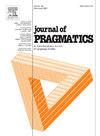#greenCNPC, #CleanerEnergy: Pragmatic use of self-praise metaphors in Chinese corporate discourse on Twitter/X
IF 1.7
1区 文学
0 LANGUAGE & LINGUISTICS
引用次数: 0
Abstract
In an era of globalized corporate communication, Chinese corporations face a pragmatic challenge of balancing cultural norms of modesty with the imperative of self-promotion on international social media platforms like Twitter/X. While metaphors offer an indirect strategy to moderate self-praise, their role in facilitating communication accommodation, particularly in cross-cultural contexts, remains understudied. This study uses the qualitative corpus analysis of tweets to investigate how two leading Chinese petroleum corporations strategically employ metaphors on Twitter to frame self-praise. This study identifies fourteen high-frequency metaphors (green, clean, friend, partner, home, smart, warm, high, low, lead, progress, advance, protect, and record) across four source domains (object, human, journey, and competition), encoding four key attributes of corporate self-praise: propriety, capacity, normality, and tenacity. Crucially, they modulate self-praise intensity via three tiers of pragmatic explicitness: explicit self-praise metaphors directly highlighting positive qualities; conventional self-praise ones aligning with cultural norms; contextual self-praise ones deriving positivity from situational framing. The analysis reveals how self-praise metaphors facilitate communication accommodation through enhancing interpretability, balancing interpersonal control, facilitating discourse management, and fostering emotional empathy. This study highlights metaphor as a dual pragmatic tool of mediating self-praise indirectness and communication accommodation and offers actionable strategies for enterprises to navigate global discourse.
# greennpc, #CleanerEnergy: Twitter/X上中国企业话语中自我表扬隐喻的实用主义使用
在企业沟通全球化的时代,中国企业面临着一个务实的挑战,即如何平衡谦虚的文化规范与在Twitter/X等国际社交媒体平台上进行自我宣传的必要性。虽然隐喻提供了一种间接的策略来缓和自我表扬,但它们在促进沟通适应方面的作用,特别是在跨文化背景下,仍未得到充分研究。本研究采用推文的定性语料库分析,考察了两家中国领先的石油公司如何在推特上战略性地使用隐喻来构建自我表扬。本研究确定了14个高频隐喻(绿色、干净、朋友、伙伴、家、聪明、温暖、高、低、领导、进步、前进、保护和记录),涵盖了四个来源领域(对象、人、旅程和竞争),编码了企业自我赞扬的四个关键属性:得体、能力、正常和坚韧。重要的是,他们通过三个层次的语用明确性来调节自我表扬的强度:明确的自我表扬隐喻直接强调积极的品质;符合文化规范的传统自我表扬;情境性自我表扬从情境框架中获得积极性。分析揭示了自我赞美隐喻如何通过增强可解释性、平衡人际控制、促进话语管理和培养情感共情来促进沟通适应。本研究强调隐喻作为中介自我赞扬间接和沟通适应的双重语用工具,并为企业在全球话语中导航提供了可操作的策略。
本文章由计算机程序翻译,如有差异,请以英文原文为准。
求助全文
约1分钟内获得全文
求助全文
来源期刊

Journal of Pragmatics
Multiple-
CiteScore
3.90
自引率
18.80%
发文量
219
期刊介绍:
Since 1977, the Journal of Pragmatics has provided a forum for bringing together a wide range of research in pragmatics, including cognitive pragmatics, corpus pragmatics, experimental pragmatics, historical pragmatics, interpersonal pragmatics, multimodal pragmatics, sociopragmatics, theoretical pragmatics and related fields. Our aim is to publish innovative pragmatic scholarship from all perspectives, which contributes to theories of how speakers produce and interpret language in different contexts drawing on attested data from a wide range of languages/cultures in different parts of the world. The Journal of Pragmatics also encourages work that uses attested language data to explore the relationship between pragmatics and neighbouring research areas such as semantics, discourse analysis, conversation analysis and ethnomethodology, interactional linguistics, sociolinguistics, linguistic anthropology, media studies, psychology, sociology, and the philosophy of language. Alongside full-length articles, discussion notes and book reviews, the journal welcomes proposals for high quality special issues in all areas of pragmatics which make a significant contribution to a topical or developing area at the cutting-edge of research.
 求助内容:
求助内容: 应助结果提醒方式:
应助结果提醒方式:


